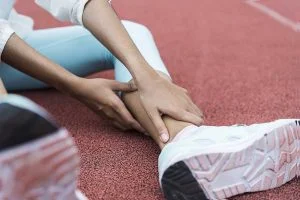Shin Pain
Also known as: Shin Splints, Medial Tibial Stress Syndrome, Anterior Shin Splints, Medial Shin Splints
Patients come in expressing frustration with the too-common pain in the lower leg. They feel pain during and even after their exercise, specifically while they run. Shin splints is a common injury for the active community which ranges in intensity, severity, and location. Athletes that do not stagger training or build on their current routine at a manageable rate risk developing this injury. When we evaluate most patients in this situation, the common theme behind their diagnosis is “you overdid it.”
Athletes should maintain their lower leg strength in order to combat this injury. A lot of pain prevention comes from strengthening and intrinsic muscle-management. They must also take part in replacing their shoes after a particular mileage (approx. 500 miles) so that they do not run on worn material. Loss of arch support and padding integrity increases the shock-load to the joints, which may in turn affect the shins. Without the proper arch support, a person’s ankles may overpronate (severely flat feet) and place even more stress on the shin bones, connective tissue, and muscles.
If not treated properly, shin splints can become a stress fracture, ultimately putting you out of your routine for even longer.
The signs and symptoms of shin splints include:
- Sharp pain on the lower end of the shin bone upon touch
- Dull, aching, radiating pain during movement
- Can also be sharp pain upon movement
- Knee Pain
- Ankle Pain
- Swelling
Lower Leg Anatomy
The tibia (inner bone) and fibula (outer bone) make up the shin. The main muscle that can contribute to shin pain is the tibialis anterior, which sits on the outside of the shin. It can be hard to identify the exact cause of the shin pain, but in relation to the anatomy, the periosteum (bone tissue) on the tibia is a site of major concern.
If you want a more in-depth anatomy of the lower leg, check out this image.
How Can You Treat Some of the Symptoms?
Some of the remedies to abate the symptoms are readily available in your very own household. Medical professionals everywhere encourage patients to implement the RICE method. Rice stands for:
- Rest – Limit or completely stop the activity that aggravates the shin pain, and switch to low-impact exercises for cross-training, if possible. Common exercises are swimming and cycling, both of which are low impact and allow the shin to heal while maintaining cardiovascular and strength capacity.
- Ice – Without putting ice directly on the skin, apply a cold pack for approximately 20 minutes. Freezing a water bottle and then rolling it onto the shin acts as an easy, comfortable way to get both the massage and cold treatment at the same time.
- Compression – Compression sleeves are available for the athlete. The sleeves encourage rapid circulation, support, and reduced shock to the area during activity. These sleeves are not a cure to shin splints or their underlying cause. You should consult your physician or Mid-County Physical Therapy to be certain that these are right for you.
- Elevate – After exercise, elevating the legs above the heart can aid in swelling prevention and lymph drainage. This is a good time to apply ice to the affected areas.
Other:
- Orthotics to improve arch support
- Second opinion – sometimes shin pain is mistaken for shin splints, when it could actually be several others including a stress fracture, compartment syndrome, or tendinitis.
- NSAIDS, or non-steroidal anti-inflammatory drugs such as ibuprofen, can also provide short-term pain relief. We encourage you to receive an assessment from the physical therapist if the pain continues or increases in intensity.
Other Treatments
There are several other treatment methods that are potentially beneficial to the individual:
- Physical Therapy: They provide a thorough evaluation, dictate an exercise and stretching plan, and use modalities such as Electrical Stimulation and Ultrasound to decrease the pain. They can also professionally apply the Kinesio Tape and focus on your form and how it relates to your injury.
- The tape can support your arches in the scenario you have flat feet, and the stretching and strengthening exercises can improve intrinsic and extrinsic muscles in the foot and ankle. This will ultimately help improve your arch strength, and prevent any pain in the shin.
- Surgery: This should be the last resort. Consult with your Physical Therapist and Primary Physician about this route.
Mid-County Physical Therapy Can Help You
During your one-on-one evaluation with the skilled therapist at Mid-County Physical Therapy, they will get to know you and your physical habits to help establish a foundation for your treatment. They will monitor and document your range of motion, techniques, and current pain-level to get a better idea of what they can do for your improvement. Before you receive treatment, it can also be beneficial to document some things such as:
- What movements cause it?
- When does it begin during activity?
- How long does it last?
- Have your home remedies stopped working?
- Do you want to maintain or improve your current fitness level?
- What are your goals?
Keeping track of this information can be essential for both you and your physical therapist.
Mid-County Physical Therapy also offers a wide variety of treatments to treat and heal your pain. Your condition could improve with a strengthening plan, which the therapist constructs based off of your individual experience. The clinic’s open-plan gym includes equipment to suit your strengthening needs while our technicians monitor to encourage proper form and maximum pain relief.
If the therapist determines you may need technique retraining, they will create a personal plan to work individually with you on form and techniques. Our clinic is also proud to offer dry-needling, kinesio taping, and even the BioQPulse. Call or contact us today to learn more about our treatment plans.


